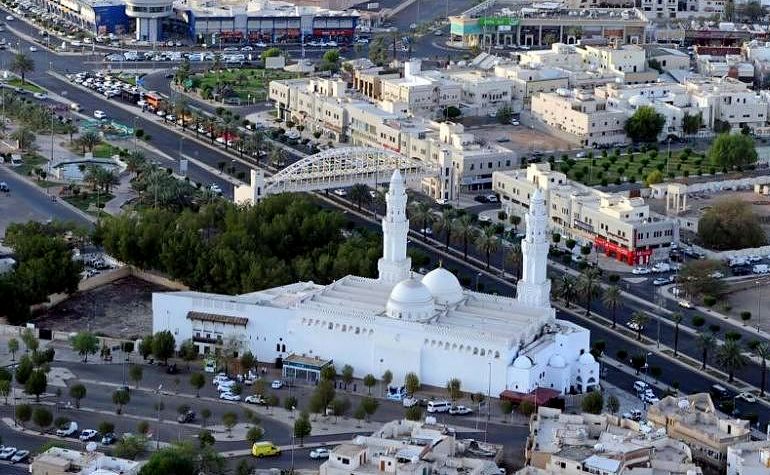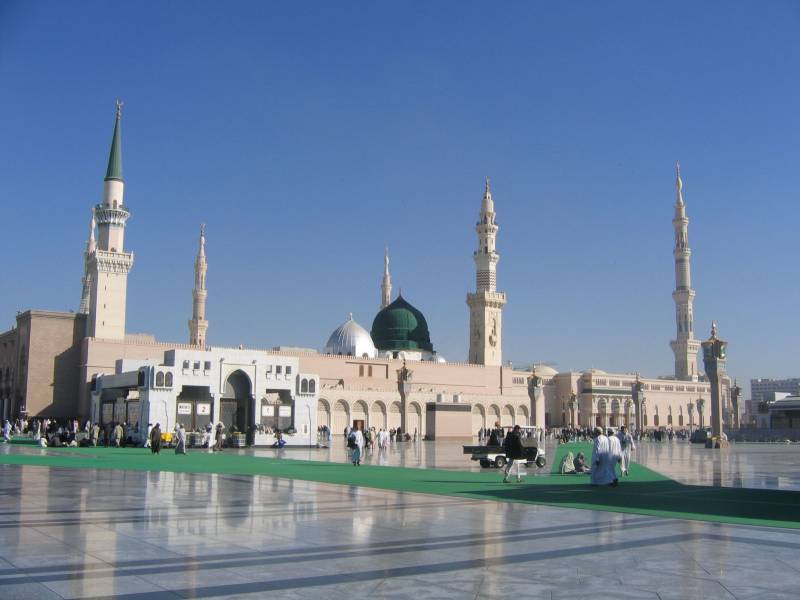It was in Medina that the Holy Prophet (PBUH) migrated from Mecca to establish Islam.
It was here that the Prophet (PBUH) built the first mosque.
It was here that the major battles were fought for the triumph of Islam.
It was from this city that Islam began spreading its divine influence throughout the world.
Medina – the city of our Prophet Muhammad (PBUH).

Masjid-e-Nabvi
These thoughts came to mind as we alighted the bus which brought us here from Mecca. Reciting Darud and salaam, we gathered our bags and headed for Sheraton Hotel to check in and freshen up after a tiring journey. Feeling hungry, I asked a hotel employee whether there was any Pakistani or Indian restaurant around. He said that just a block away there was a good Bengali café. We went there and were served one of the tastiest meals I ever had. It cost only thirty-two Riyals (approx. 10 US Dollars) for our party of five. The five- Riyal tip was graciously returned to us by the owner, saying that they do not accept tips from pilgrims.
Ten minutes later, we were at the entrance of Masjid-e-Nabvi; the splendor and majesty of the mosque with its green tomb and the surroundings at once held me breathless. Herein rests our beloved Prophet (PBUH) with the choicest blessings of Allah. The main mosque was closed, as it closes every night at ten-thirty, but I just wanted to pay respect and pray for a while which I did whole-heartedly
After a restful sleep that night, we came back to the mosque to offer fajr prayers. The Prophet’s resting place was jam-packed with pilgrims and we were not allowed to enter, but I was able to get in between Maghrib and Isha prayers. It was an ecstatic moment. Every inch of the place seemed to be blessed by Allah, and I could suddenly feel that a little spark of blessing was overpowering me!
.jpg)
Inside Masjid-e-Nabvi
“Peace be upon you, oh, Messenger of Allah. Oh, most exalted of Allah’s creations. Peace be upon you,” I began to pray and was lost in the serene atmosphere for quite some time. Though the holy place was crowded and I could hardly manage to stand squeezed on both sides, I offered two Rakats, and then prayed for everyone I knew and I prayed for the whole Ummah, all mankind and for peace in the world. Finally, I prayed for my family, my loved ones and for me.
My wife, however, could not enter as ladies are allowed inside only at specific times. She did go in the next day after fajr prayers.
The Prophet (PBUH) has said that a Salah offered in this mosque is more precious than a thousand Rakats at any other place, except at Masjid-al-Haram in Mecca, so we offered as many prayers as possible during our stay in Medina.
Sacred Mosques and Historical Sites
The next day we hired an air-conditioned coach to visit some sacred mosques and historical sites. It turned out that the air conditioning of the vehicle was defective. Every time it was turned on, it made a shrill sound like a bird in distress. The driver apologized profusely, but he made up by offering us cold Zam Zam water every now and then. What appeased our mood was that he was an expert guide, knew everything about the places we visited.

Masjid-e-Quba

Masjid-e-Zul Qiblaitain
The first place we visited was Masjid-e-Quba, a very impressive mosque, the foundation of which was laid by none other than our beloved Prophet. We offered two Rakats of Nafl prayers, as it is said that this prayer is equivalent to performing one Umrah!
Masjid-e-Zul Qiblaitain is the mosque where the Holy Prophet(PBUH), during a prayer, was ordered by Allah to turn his face from Islam’s first Qibla Baitul Muqaddas in Jerusalem to Kabah in Masjid-al-Haram in Mecca. As such, it is called Masjid-e-Zul Qiblaitain which means the mosque with two Qiblahs.
There are several other mosques of importance which we saw, like Masjid-e-Jumua, a place where the Prophet(PBUH) offered his first Jumua prayers in Medina. The mosques of Hadrat Abu Bakr, Hadrat Usman and Hadrat Ali are all nearby offering splendor to the city.
The plain of Badr is about ninety-five miles south of Medina, and Jabal-e-Uhud and Uhud graveyard are towards the north of the city. It is known for the battle of Uhud and the burial place of Hadrat Hamza and some other Companions. We could actually see the mount and the passageway where, as per our historians, some archers stationed during the battle prematurely left their post, defying the instructions of the Prophet(PBUH) and thinking that the battle was already won. This had resulted in a big upset and the loss of many valiant fighters.

Badr

Jabal-e-Uhud
Jabal-e-Salaa is where the battle of Trenches was fought, giving a crucial victory to the Muslims.
We came back and entered Masjid-Nabvi to visit Jannat-al-Baqaa to offer fateha. Unfortunately, we could not see the actual resting places of the Companions, wives and daughters of the Prophet (PBUH) because a huge wall has been constructed in front.
Not far from the mosque is Masjid Ghamama, where the Holy Prophet (PBUH) used to offer Eid Prayers. It is said that when once the city had gone dry, because there was no rain for quite some time, the Prophet (PBUH) led Istisqaa prayers in this mosque; and suddenly thick black clouds formed in the sky and it began raining. That’s why it is called Ghamama, meaning clouds.
Finally, the day of departure came and we bade farewell the serenity of the city of the Prophet (PBUH), boarding a limousine that would take us to Jeddah International Airport.






